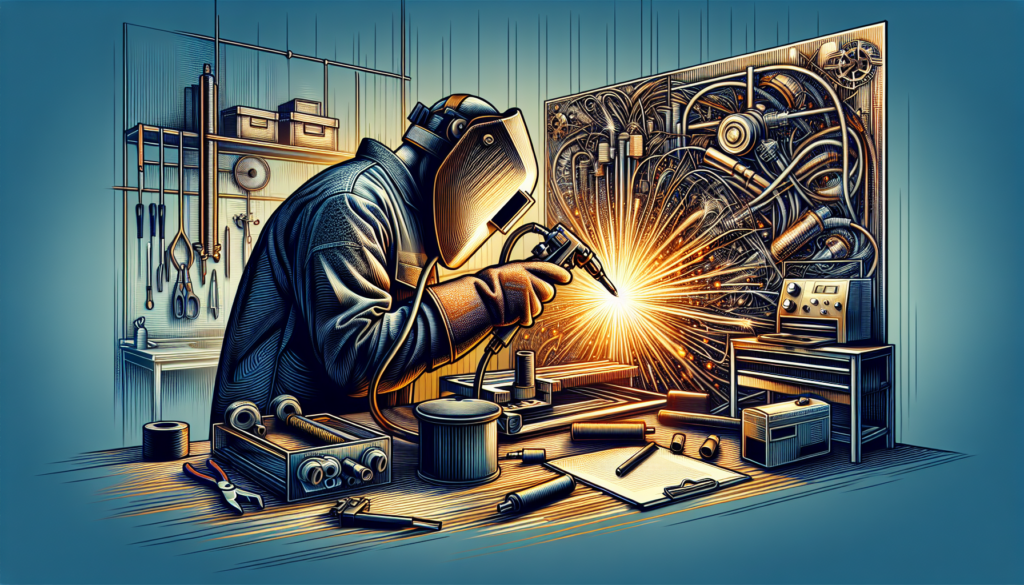Looking for a rewarding career in welding? Look no further! This article is your ultimate guide to finding the perfect job for welding. Whether you’re a seasoned professional or just starting out, we’ve got you covered. From the best industries to work in, to tips for landing your dream job, we’ll provide all the information you need to kickstart your welding career. So grab your helmet and let’s get started!
Job For Welding

Introduction to Welding
If you have a passion for creating, fixing, and working with metal, then a career in welding could be perfect for you. Welding is a skilled trade that involves joining metal pieces together using various techniques. It is a crucial part of construction, manufacturing, and repair industries. In this comprehensive article, we will explore the different types of welding jobs, the skills required for success in this field, the education and certification opportunities available, the work environment you can expect, the salary and job outlook, the advantages and disadvantages of welding jobs, the types of industries hiring welders, the steps to begin a career in welding, and the future trends and innovations in this exciting field.
Types of Welding Jobs
Welding offers a diverse range of job opportunities, each requiring a specific set of skills and expertise. Some of the common types of welding jobs include:
1. Structural Welding
Structural welders specialize in joining large metal pieces used in the construction of buildings, bridges, and other infrastructure. They must be proficient in techniques such as arc welding, MIG welding, and TIG welding.
2. Pipe Welding
Pipe welders focus on joining pipes used in plumbing, gas, and oil industries. Working at various locations, they must possess expertise in welding techniques suited for different materials like steel, stainless steel, and aluminum.
3. Aerospace Welding
Aerospace welders deal with the fabrication and repair of aircraft components. Precision and attention to detail are critical in this field, as any flaw could have severe consequences.
4. Underwater Welding
Underwater welders are skilled professionals who work beneath the water’s surface to repair and maintain structures such as offshore oil rigs, bridges, and ships. They must be proficient in both diving and welding techniques.
Skills Required for Welding Jobs
To excel in welding jobs, several essential skills are necessary. These include:
1. Technical Skills
Welders need to possess a solid understanding of different welding techniques, equipment operation, and safety procedures. They must know how to read blueprints, interpret welding symbols, and perform accurate measurements.
2. Hand-Eye Coordination
Precise hand-eye coordination is crucial for welders as they work with intricate metal pieces. The ability to manipulate the welding torch or electrode with precision ensures clean and accurate welds.
3. Physical Stamina
Welding can be physically demanding, often requiring prolonged periods of standing, bending, and working in confined spaces. Good physical stamina and strength are essential to handle the equipment and maneuver heavy materials.
4. Attention to Detail
Welders must have an eye for detail to ensure all welds meet the required specifications and standards. Identifying imperfections, such as cracks or weak joints, is critical to producing high-quality work.
Education and Certification for Welding Jobs
While a high school diploma is typically the minimum educational requirement for most welding jobs, further education and training can significantly enhance your career prospects.
Many vocational schools and community colleges offer welding programs that provide hands-on training in welding techniques, metallurgy, blueprint reading, and safety procedures. These programs may range from a few months to a year, depending on the level of certification desired.
Obtaining certifications from recognized organizations such as the American Welding Society (AWS) can also greatly improve your job prospects. Certifications, such as Certified Welder, Certified Welding Inspector, and Certified Welding Educator, demonstrate your competence and proficiency in specific welding techniques and quality control processes.

Work Environment for Welding Jobs
Welders can find employment in a wide range of industries, both indoors and outdoors. Depending on the specific job, work environments may vary. Welders employed in construction or manufacturing settings may work in large, well-ventilated shops, while others may find themselves working in confined spaces, at great heights, or even underwater.
Safety is a top priority in welding, and welders must follow strict safety protocols to protect themselves and others. This includes wearing protective clothing, such as flame-resistant suits, gloves, and helmets, as well as using ventilation systems and personal protective equipment to minimize exposure to fumes, sparks, and radiation.
Salary and Job Outlook for Welding Jobs
Welding offers a promising career path with steady demand and competitive salaries. According to the Bureau of Labor Statistics, the median annual wage for welders, cutters, solderers, and brazers was $44,190 in May 2020. However, wages can vary depending on factors such as industry, location, experience, and certification level.
The job outlook for welding careers is also favorable. The need to repair and maintain infrastructure, construct new buildings, and replace aging pipelines ensures a continual demand for skilled welders. As technologies continue to evolve, welding professionals with expertise in advanced techniques and automation will be particularly sought after.
Advantages and Disadvantages of Welding Jobs
Like any other profession, welding jobs have their advantages and disadvantages. Let’s take a closer look at some of them:
Advantages
- High Demand: Welders are in high demand across various industries, offering a plethora of job opportunities.
- Skills Portability: Welding skills can be transferred between industries, providing flexibility and diverse career options.
- Potential for Entrepreneurship: Skilled welders can choose to start their own businesses and work independently.
- Job Satisfaction: Seeing tangible results of your work, whether it’s constructing a bridge or repairing a machine, can provide a great sense of accomplishment.
Disadvantages
- Physical Demands: Welding can be physically demanding, requiring prolonged periods of standing, carrying heavy materials, and working in challenging conditions.
- Safety Hazards: Welding involves exposure to high temperatures, fumes, and radiation. Following safety protocols is crucial to minimize the associated risks.
- Limited Career Progression: Advancement opportunities may be limited without further education, certifications, or pursuing specialized welding techniques.
Types of Industries Hiring Welders
Welders are needed in various industries, including:
1. Construction
Construction companies require skilled welders to join structural components, work on building frameworks, and fabricate metal parts needed for construction projects.
2. Manufacturing
In the manufacturing sector, welders are involved in fabricating, assembling, and repairing metal parts used in the production of automobiles, appliances, machinery, and more.
3. Energy and Utilities
Welders play a vital role in the energy and utilities industry, where they assist in the construction and maintenance of oil and gas pipelines, power plants, and refining facilities.
4. Aerospace and Defense
Aerospace and defense industries require welders to manufacture and repair aircraft components, spacecraft, and defense equipment with precision and adherence to strict quality standards.
Steps to Begin a Career in Welding
If you’re interested in pursuing a career in welding, here are the steps you can follow:
1. Research and Explore
Take the time to research the field of welding to gain a better understanding of the different types of welding jobs, required skills, and the industry’s future trends. This will help you make an informed decision about your career path.
2. Obtain Education and Training
Enroll in a welding program offered by a vocational school or community college. These programs provide hands-on training, teach welding techniques, and cover essential topics such as blueprint reading, metallurgy, and safety procedures.
3. Gain Practical Experience
Once you have completed your training, look for opportunities to gain practical experience through internships, apprenticeships, or entry-level positions. This will allow you to apply your skills in real-world scenarios and further develop your expertise.
4. Get Certified
Consider obtaining certifications from recognized organizations such as the American Welding Society. Certifications enhance your credibility and demonstrate your commitment to excellence in the field of welding.
5. Build a Network
Networking is crucial in any industry. Attend welding conferences, join professional organizations, and connect with experienced individuals in the field. Building relationships can lead to better job opportunities, mentorship, and valuable advice.
Future Trends and Innovations in Welding
Welding technology is constantly evolving, providing exciting opportunities for welders and shaping the industry’s future. Here are some of the current trends and innovations in welding:
-
Automation and Robotics: Advances in robotics are revolutionizing welding processes, increasing efficiency and precision while reducing the risk of human error.
-
Laser Welding: Laser welding offers benefits such as reduced heat input, faster welding speeds, and high-quality welds. It is becoming increasingly popular in industries where precision is crucial, such as aerospace.
-
3D Printing: Additive manufacturing techniques, including 3D printing, are being integrated with welding processes, allowing for complex structures and customized components to be created with ease.
-
Augmented Reality: Augmented reality welding simulators are being used to train and improve the skills of welders by providing realistic virtual environments to practice in.
As the demand for efficient and sustainable manufacturing grows, expect to see further advancements in welding technology, materials, and techniques.
In conclusion, a career in welding offers a world of opportunities for those with a passion for working with metal. By acquiring the necessary skills, education, certifications, and practical experience, you can enter this field confidently. Remember to stay updated with the latest industry trends and innovations to remain competitive and contribute to the exciting world of welding. So, get ready to don your welding helmet and embark on a fulfilling career that allows you to build, repair, and shape the structures and objects that make our world possible.
